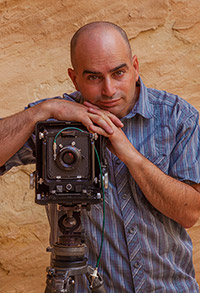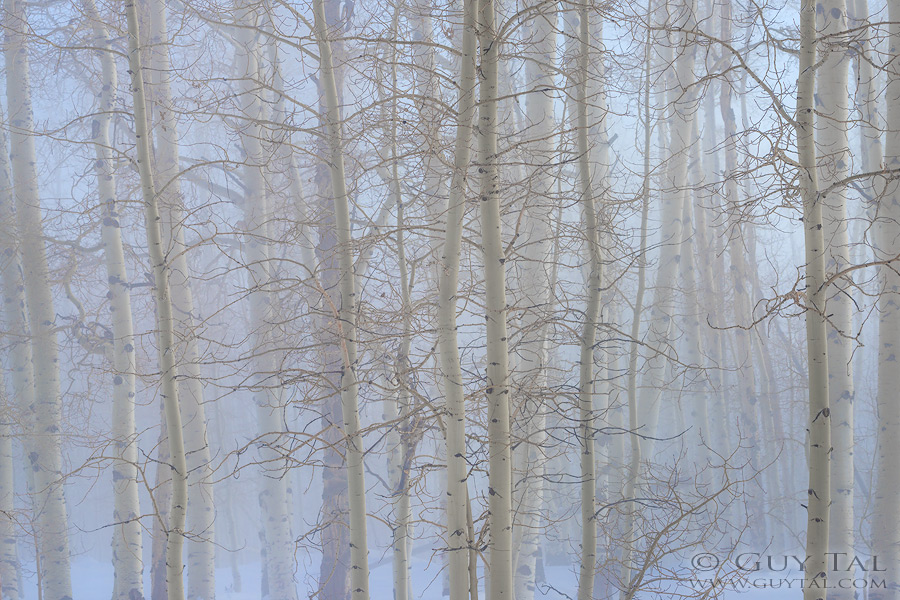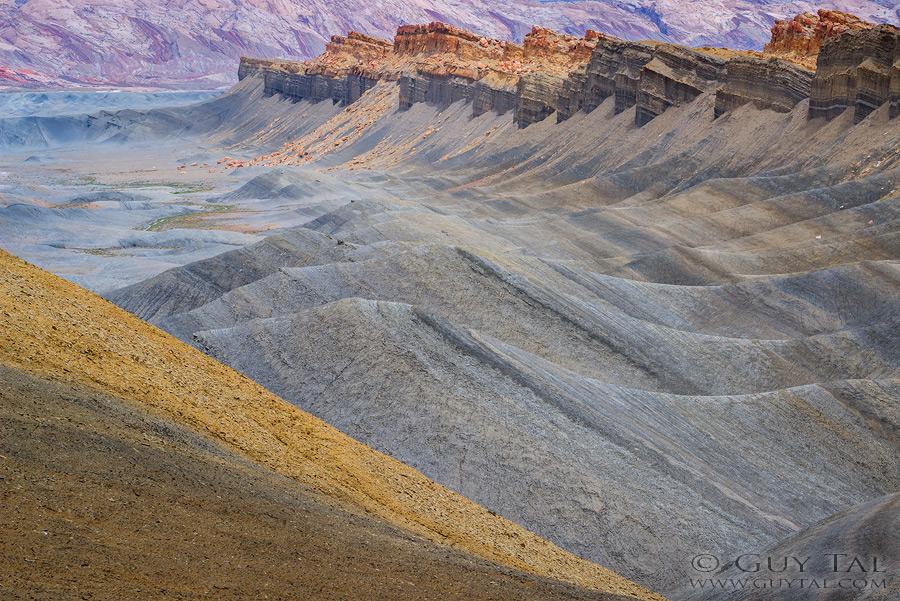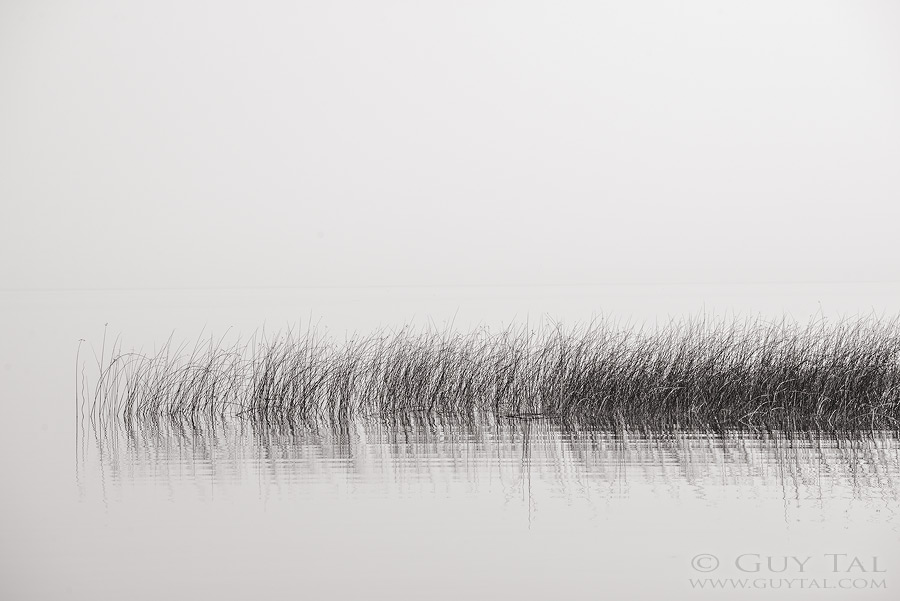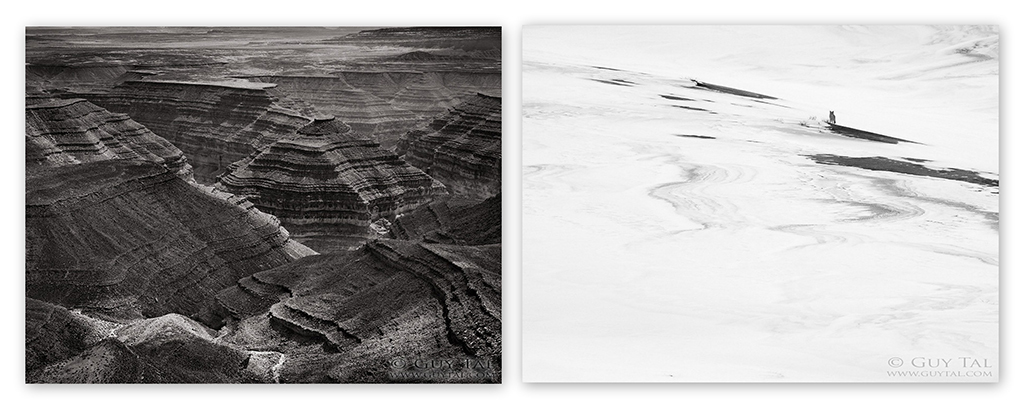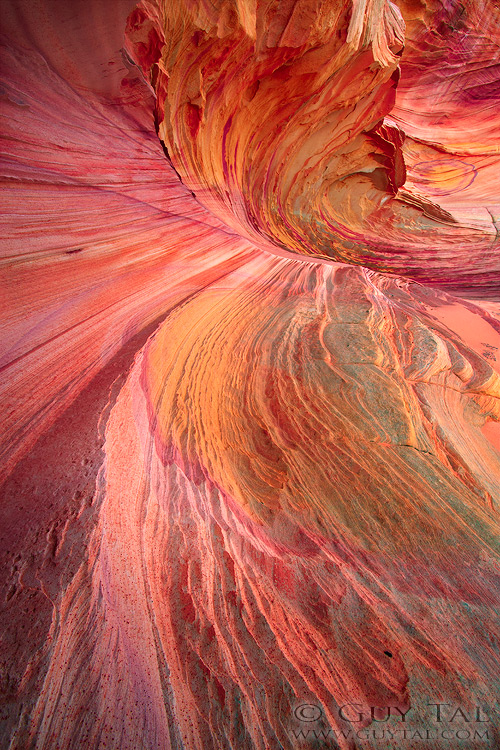Vision Drawings: Session #3
Guy Tal offers the viewer an evocative and metaphorical approach to landscape photography that often straddles the line between natural abstracts and painterly sculptures of light and shadows . He is an explorer that expresses the world around him in intimate ways with both colour and black and white photography. He is also an established educator that offers an insightful, intellectual and imaginative foray into photography while embracing theories and philosophies across art, science and spirituality. As I always have the pleasure of delving deeper into ideas with those I interview behind the scenes, what struck me was that Guy and I speak a complimentary language of the subjective and objective intricacies and principles of photography but in our own ways. If this is your first introduction into Guy’s photography, this interview reveals a substance of character and something much more than your traditional photography interview. These series of interviews are based on the core principles of my psychology of photography: “Vision Drawings (Oramagraphy)”.
Self-Introduction:
I am a professional artist, author, photographer, educator and public speaker. I believe that the practice of creative pursuits manifests not only in the making of art, but also has the ability to transform and enrich life, facilitate meaningful and rewarding experiences, and foster contentment and satisfaction through life-long discovery and learning.
In photography I strive to create images that speak to wildness – the quality of being attuned to, and inspired by, the wild. Many of my images also articulate my intimate connection with the natural landscape, particularly that of my home, and the friendship I found with certain places. Rather than glimpses of superficial beauty, I wish for my work to speak to a deep familiarity with my subjects, revealing something of the role they play in my life – a relationship as intricate as any I have had with another person. The things I photograph are not just attractive models to me, they are temples and sanctuaries and multi-dimensional characters in my own story, as I am in theirs.
I do not photograph for the sake of photography, and not to simply document the external appearance of things, no matter how objectively appealing. Instead, I photograph as a means of exploring and expressing things that I cannot express in any other way, and because it is important to me to share them. Put another way, I do not photograph things, I photograph my love for them, and sometimes I photograph my love through them.
I do not consider myself a photographer who creates art, but rather an artist working in the medium of photography. Where some photographers take a representational approach to the landscape, I wish instead to use visual elements and natural aesthetics as evocative metaphors, creating images that are not merely of, but rather about ideas, places and things that have become personally meaningful to me.
All Images © Guy Tal
Q1. Prescience (Frame of Vision): Photographic vision is often considered an ambiguous but autobiographical notion, an ethereal but practical insight for the photographer into the invisible world made visible through a process of discovery (e.g., previsualization) and time in the darkroom (e.g., post-processing). When you consider this series of photos, how would you describe your own photographic process before, during and after you take the photograph and why you chose to make the photographs the way you did?
I think that all creative works start with an intuition, which I refer to in my writings as the Concept behind a given work, or body of work. It is indeed ambiguous in the sense that it is an inner response to some stimulus (which can be anything) but does not yet have any literal characteristics that make it expressible in tangible form. The discovery, for me, precedes any considerations of photography. Photography is just one means for expressing, or realizing, a Concept, once already discovered. Discovery, for me, follows from the way I interact with the landscape and having the time to explore and wait as needed, rather than rush to make an image. It comes from conditioning the mind to be open, receptive and responsive in general, and doesn’t have to manifest in a photograph. In that sense the discoveries that end up inspiring photographs are just a subset of those experienced in the course of life.
Process is something that I engage in once the intuitive decision to make a photograph is already made (to use Psychological terminology: process refers to the non-cognitive aspects of making an image). It is the guiding of the abstract Concept down a series of decisions and applications of various tools, skills and materials to give it tangible form.
The most important part of the process, for me, is Visualization – the seeing in the proverbial “mind’s eye” of the finished image before applying any tools or technical skills. Visualization utilizes the brain’s ability to form an image without visual stimulation, which is a remarkable feat. It is distinct from vision in the sense that vision reveals to us what is, while visualization allows us to imagine what can be. Visualization provides me with a desired outcome – a target to aim for – and in that sense it drives all other parts of the process, which are aimed at transitioning the virtual image in my mind into a tangible one that can be shared with others
I do warn students to not let their visualization be prescriptive. Just because you imagine an image one way at one time doesn’t mean that you should not consider other options as you go along. It is the nature of creativity that the light bulb can go on at any time and suggest more effective outcomes.
Once I have a visualized image in mind, I proceed to Composition. Composition is often approached with the limited mindset of making an image more visually appealing, but there is a lot more to it than that. I like to think of images as being rendered in a form of language – a visual language. That is, every visual element, by itself or in relation to others, has an effect on the viewer – it communicates something. This was a topic of much research and fascinating discoveries in what some may know as Gestalt psychology.
Continuing the language analogy, composition can be thought of as the grammar, or structure, of the visual language. And, as with all languages, composition is the deliberate act of arranging things (letters, words, musical notes, visual elements, etc.) in a particular way so they express a desired message or story (in this case, the Concept).
With a composition in mind, I proceed to the simplest task of photography – Capture, or as you refer to it: the taking of a photograph, though in my work it is really just another step in the making process. By Capture I mean the mechanical act of recording reflected light using a camera. It requires less cognitive skill than other aspects of creative photography, but is nonetheless essential. Another way to think about Capture is as the harvesting of ingredients to later use in the crafting of the final presentation.
At the studio I continue by Processing and Post-Processing (these terms relate to different activities, depending on whether you use film or digital capture) the captured data with the goal of producing a master file that looks like the visualized image. And, from this master file, I later produce multiple forms of output (web images, prints, etc.) that I refer to collectively as Presentation – the point at which your work meets its audience.
Q2. Paradox (Frame of Change): Photographers often strive for personal satisfaction first and originality second. However, each photographer offers a signature moment of personal originality that resonates with themselves and others as part of their development as artists. Is there a photo(s) that did that for you? What do you think your photos say about you as a photographer?
I don’t feel that originality is something to strive for, not even as a secondary aspiration. It is something that ensues naturally out of embracing higher goals, such as living deliberately, embracing who you are, and expressing yourself in creative work. Creativity, by definition, implies originality. Also, by virtue of each of us being unique in so many ways, work originating from personal convictions and sensibilities is inherently original, too.
Personal satisfaction (what psychologists refer to as Flow) is indeed a primary driver in my process. It is why, as an artist, I value process over outcome (which may, appropriately, be the reverse of how most of my viewers feel). I think this is a point missed all too often by those seeking to make their process faster, more efficient (as measured by volume) or more automated. Psychologist Mihaly Csikszentmihalyi explains why shortcuts ultimately deprive us of some of the most rewarding aspects of creative work: “Contrary to what we usually believe … The best moments usually occur when a person’s body or mind is stretched to its limits in a voluntary effort to accomplish something difficult and worthwhile.”
To answer your first question, I actually can’t think of such a moment or photo in my past. My work progressed and evolved, sometimes gradually and sometimes in a punctuated way, for nearly three decades now. I can think of many anecdotal revelations that added up to what I do today (and which, I hope, will continue to evolve) but no “aha!” moments directly related to photography. If anything, the great shifts in my photography coincided with great shifts in my life, driven by decidedly un-photographic events and realizations.
My response to the second question also explains my answer to the first: I hope my photos do not pigeonhole me as being just a photographer, because that’s not how I think of myself. I hope they speak to who I am as a person, beyond the medium I happen to be working in.
Let me elaborate for the sake of consistency as these ideas also inform my other answers below. In my Artist Statement, which I quote above, I make this distinction: I do not consider myself a photographer who creates art, but rather an artist working in the medium of photography. To me, the term Artist better describes the person that I strive to be, and is only indirectly linked with the (quite random) fact that I happen to use a camera in some of my work. I picked up photography in my mid-teens with no aspirations for, or understanding of, art. It was just something fun and useful to do on my outdoor explorations. But with experience I became skilled in it and, when I realized my aspiration to become an artist, the camera just happened to be available to me. If at the time I possessed similar skill in painting or music, I likely would have reached for these just as readily as I did photography.
Most people today compartmentalize their lives into distinct categories: work life, family life, photography life, social life, personal life, etc. and often take on somewhat different personalities in each of these roles. I worked hard to tear down these separations in my own life. I don’t “work” at certain times and places, I create and think creatively almost all the time, everywhere. When something arises within the stream of consciousness that is my life that may be expressible in a photograph – I’ll photograph it. If it’s a complex idea better explained in writing – I’ll write about it, and so on. But, there is no “photographer me” that is distinct from “writer me” any other “me.”
With that in mind, I hope that my images speak to three things: my inner world (feelings, thoughts, sensibilities, etc.), my creativity, and the way I experience the outer world at particular times in my life.
Q3. Parallels (Frame of Relations): The elements of a photograph come together in harmony to communicate an admiration of a subject, to provide an interpretable story in a stilled moment, and foster a relationship between the photographer and the viewers. Although we often want the viewer to provide their own insights into our photographs, what do you think people notice the most about your work (e.g., an underlying theme) and why?
In a separate discussion you clarified your use of the term subject to mean what the artist presents to their audience. In my own framework this correlates with what I call the Concept. Subject to me is simply the thing(s) being photographed. With that in mind, certainly some of my work is driven by admiration of subject, but not all. In some cases an image may be about my relationship with a particular subject (what Minor White called a Pictorial photograph, though he used the term incorrectly) and in other cases the subject is of no consequence at all, but merely a vehicle – a visual metaphor – for something that is entirely of my own conception and that gets expressed through the subject (what Alfred Stieglitz, Minor White and others referred to as an Equivalent photograph).
The relationship with the viewer is very important, but there are two ways to approach it: we can create images with the explicit goal of appealing to others, or we can create to satisfy ourselves, trusting that there are others out there who share some of our sensibilities and who, in time, will discover and become interested in our work. I prefer the latter. In other words – I prefer that the relationship ensue out of the work, rather than aim for mass appeal.
There is always an element of personal interpretation by a given viewer that I cannot know or control, so I am sometimes surprised by viewers’ preferences, but for the most part my goal is to use aesthetics as a vehicle for evoking a specific emotional response. I think that most people do notice the aesthetics, which require less effort and attention to appreciate, and some of them also experience the emotional effect. It is this latter sub-section of viewers that I consider my audience.
That said, this actually is not something I consciously account for as I make my images, for the reason I mention above: I prefer for the work to draw its own audience rather than to adapt it to reach more people. Certainly I’d be concerned if I received little or no response, but as long as I can see that I am, in fact, reaching an audience of like-minded people I don’t worry too much about it.
All Images © Guy Tal
Q4. Perception (Frame of Reference): You have probably heard the adage about there being as many realities as there are people but there is one thing that seems to be quite universal: the sense of wonderment about the beauty we create in moments and the emotion that encapsulates it all. I am fond of saying that the complexity of beauty gives the artist a beautiful complex. How and why has photography changed the way you sense and perceive the world?
Certainly beauty and wonder are what makes my kind of art both possible and rewarding, but it is not limited to the beauty I find and capture, it also extends (perhaps even more so) to the beauty I create. Finding and capturing are limited by aesthetics already inherent in the subject; creating, on the other hand, allows us to make beauty where little or none existed in the first place (at least not in an obvious way), and is therefore a harder and more noteworthy accomplishment in my mind.
I am something of a science buff and one area I’m paying attention to these days is the relatively new science of neuroaesthetics, attempting to decipher how the brain experiences beauty. The reason I mention this is to illustrate in a more literal way the complexity you mention and how little we know about it. One of the pioneers of neuroaesthetics is the brilliant neuroscientist V.S. Ramachandran. Recently, while driving, I listened to an interview with him in which the interviewer asked how much science can tell us about what we experience when stimulated by art. Ramachandran’s response was so striking to me that I had to pull over and write it down:
“I think right now one percent or less is explained by neuroscience, but I think a time will come when we’ll maybe understand ten or twenty percent of it.”
Regarding your question, I would say that it’s not so much photography that changed the way I perceive the world as the opposite: the evolution of the way I perceive the world changed my photography over time. More specifically, it transformed my photography from being primarily representational to being primarily creative. I don’t necessarily seek things that are already aesthetically pleasing or emotionally moving, I prefer instead to set the bar a little higher: I want to use the visual characteristics of various subjects in order to convey something (both aesthetic and emotional) originating from my own mind, rather than something objectively inherent in the scene.
Q5. Personality (Frame of Mind): If you had to describe yourself as a photographer using three distinct words, what would they be and why? Are there hints in these photographs that speak to your individuality or essence as a photographer?
I hope you don’t mind if I substitute “person” or “artist” for “photographer,” for the reason I describe above. I suppose the three words would be: creative, expressive and responsive. I’ll elaborate on each:
Creative
A widely used definition for creativity in academic studies (coined by Michael Mumford) is: “the production of novel, useful products.” I.e., it is not enough for something to be novel (original) to be considered creative, it should also be useful. In art, usefulness can be considered as the degree to which it enriches the experience of the viewer.
Deconstructing the definition, production refers to the application of skill and craft. I am very nitpicky about the technical qualities of my work and go to great lengths to set them as high as I possibly can. Novel refers to originality, which in my way of thinking is not something deliberate but rather a by-product of expressing my own unique sensibilities and disregarding factors such as safety (in the sense of critical reception), ease, popular appeal, etc. Usefulness, as I mention above, is simply a measure of whether the work achieves its intended effect, which for the most part I believe it does.
Expressive
Much art today is created under the banner of “art for art’s sake,” which may seem a benign credo until you realize that what it really means is that art should have no relation to human experience. My art does not fall into this category. I expressly seek to affect other people, to inspire and to be inspired by them, and to reveal to them things I feel are worthwhile and that otherwise may not be revealed by anyone else. In other words, my work is an expression of concepts originating from my own psyche, rather than driven by objective qualities of the subject, or popular opinion.
Responsive
Some art consists entirely of manufactured realities, invented by the artist with no relation at all to real subjects or events. I admire artists who can do that well. Alas, I can’t. My art always is a response to something outside of me, filtered through my own sensibilities, imagination and perceptions. I always need a trigger to send me down the path of making an image. From that point on I feel no obligation to remain faithful to the literal subject, but I do retain and carry through the impression that inspired me to make an image in the first place.
I sometimes think of my images as the equivalents of journal entries. They are founded in fact, but articulated from a personal and biased perspective, describing true events, but doing so in subjective terms.
All Images © Guy Tal
Q6. Progression (Frame of Time): Although the “what inspires you” question is tried and true, I want to ask it in a different way: what do you think will inspire people about you and your photography in a few years time and why? Is there any advice that you would give fellow photographers about things they need to do to gain confidence or avoid on the road to self-fulfillment as artists that you wish you knew years ago?
In response to the first question: I don’t know and I’m not too concerned about it. I can tell you what I hope may inspire people, and photography is just a small part of it. I strive (sometimes unsuccessfully) to live up to Gandhi’s words: “my life is my message.”
Photography is just one means of expressing greater things about the way I live, and my reasons for living as I do. I left my home country to pursue a better life, I resigned a successful and well-paying corporate career to become an artist, I left the mass of humanity to live in the proverbial “middle of nowhere,” and I spend the majority of my time in solitude. I deliberately examine, research and seek to understand everything that is important to me: from my own lifestyle and artistic motivations, morality, hard science, and all the way to what some people term “spirituality,” which I think most readers will intuitively understand, despite being an overloaded term (and by it I do not specifically mean religion, though I’m sure it is to some).
Answering the second question, fulfillment cannot be founded on something external to yourself, including photography. It has to arise from the way you engage with, and respond to, the world – a holistic perception of a “right” way to live, think and act. To find fulfillment in your creative endeavors you must first have a good idea of what fulfillment means in a general sense – in the way you think, in the things you find noble and worthwhile, in the values you hold and that you will not compromise, in the way you learn and interact, in the way you respond to beauty or adversity, etc.
Also, do not strive to become a master. Mastery in art is a sad state – it is a state of stagnation, when one falsely believes they have nothing left to learn or improve upon. It is a state of willful ignorance and even arrogance. There are too many people in this business calling themselves masters, not realizing that by adopting such an attitude they also place an immutable obstacle in their own creative path – their ego.
Be humble and grateful for the immense gifts of consciousness and creativity, and do not let them go to waste. Embrace the things that make you unique, even when they do not align with the desires or sensibilities of others. Become who you are and you will be fulfilled, no matter what you do or what life throws your way.
Q7. What one insight did you gain about yourself as a photographer after going through these questions?
Self-examination is always a good thing, and having a framework to guide one through such exercises is indeed helpful, so long as the framework is not too rigid. Art, by its nature, is ambiguous. Or, as beautifully articulated by Albert Camus: “art lives only on the restraints it imposes on itself, and dies of all others.”
One thing I appreciated about the questions is that they examine concepts I thought about previously, but do so using a perspective and terminology that is a bit different from my own. In that sense they help both affirm and contrast some of my own ideas.
Personal Website: http://guytal.com
Facebook: https://www.facebook.com/guytalphoto
Blog: http://guytal.com/wordpress
Bookstore: http://guytalbooks.com
FIN

